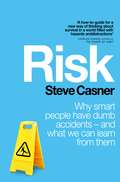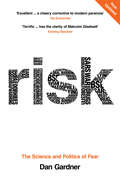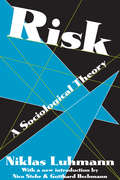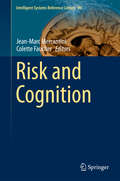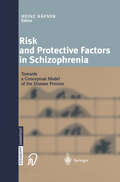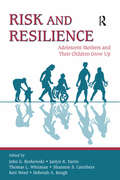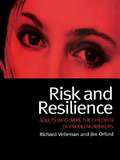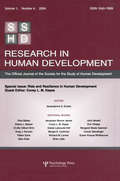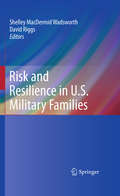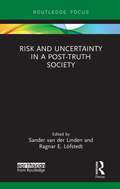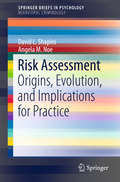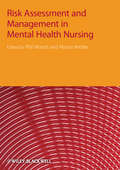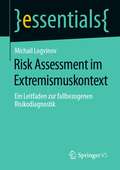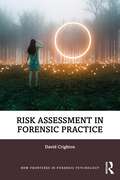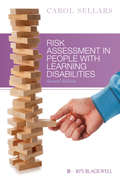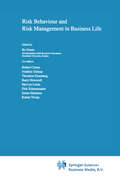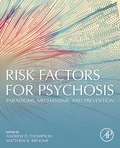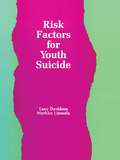- Table View
- List View
Risk: Why Smart People Have Dumb Accidents - And What We Can Learn From Them
by Steve CasnerPreviously published as Careful!The modern world can be a dangerous place, filled with fast cars, smart phones, drugs and extreme sports. Meanwhile, we humans are as fragile as ever. In fact, after a century of decline in injuries and accidental deaths they are on the rise again. The question is – why? Steve Casner has devoted his career to studying the psychology of safety, and he knows that there’s not a safety warning we won't ignore, or a fool-proof device we can't turn into an implement of disaster. Based on years of research and understanding of human behavior learnt as a research psychologist, Risk is the definitive user-guide to avoiding everyday calamity. It will help us understand why we behave in such contradictory ways – insisting on fat-free salad dressing but then texting while driving – and explain the psychological traps that can lead us to the scene of an accident. By showing us how and when injuries happen, we learn what we should really be worrying about.Helping to keep our fingers attached in the kitchen, our children afloat at the pool and teenagers safe behind the wheel, Casner shows us all the ways we can take control of our own safety and get through the day in one piece.
Risk: The Science and Politics of Fear
by Dan GardnerWe are the safest humans who ever lived - the statistics prove it. And yet the media tells a different story with its warnings and scare stories. How is it possible that anxiety has become the stuff of daily life?In this ground-breaking, compulsively readable book, Dan Gardner shows how our flawed strategies for perceiving risk influence our lives, often with unforeseen and sometimes-tragic consequences. He throws light on our paranoia about everything from paedophiles to terrorism and reveals how the most significant threats are actually the mundane risks to which we pay little attention.Speaking to psychologists and scientists, as well as looking at the influence of the media and politicians, Gardner uncovers one of the central puzzles of our time: why are the safest people in history living in a culture of fear?
Risk: A Sociological Theory
by Niklas LuhmannA great deal of attention has been devoted to risk research. Sociologists in general have limited themselves to varying recognitions of a society at risk and have traced out the paths to disaster. The detailed research has yet to be undertaken. In Risk, now available in paperback, Niklas Luhmann develops a theoretical program for such research. His premise is that the concept of risk projects essential aspects of our description of the future onto the present. Risk is conceived as the possibility of triggering unexpected, unlikely, and detrimental consequences by means of a decision attributable to a decision maker.
Risk: A Sociological Theory
by Niklas LuhmannA great deal of attention has been devoted to risk research. Sociologists in general have limited themselves to varying recognitions of a society at risk and have traced out the paths to disaster. The detailed research has yet to be undertaken. In Risk, now available in paperback, Niklas Luhmann develops a theoretical program for such research. His premise is that the concept of risk projects essential aspects of our description of the future onto the present. Risk is conceived as the possibility of triggering unexpected, unlikely, and detrimental consequences by means of a decision attributable to a decision maker.
Risk and Cognition (Intelligent Systems Reference Library #80)
by Jean-Marc Mercantini Colette FaucherThis book presents recent research using cognitive science to apprehend risk situations and elaborate new organizations, new systems and new methodological tools in response. The book demonstrates the reasons, advantages and implications of the association of the concepts of cognition and risk. It is shown that this association has strong consequences on how to apprehend critical situations that emerge within various activity domains, and how to elaborate responses to these critical situations.. The following topics are covered by the book:· Influence of the culture in risk management,· Influence of the risk communication in risk management,· User-centred design to improve risk situation management,· Designing new tools to assist risk situation management,· Risk prevention in industrial activities.
Risk and Protective Factors in Schizophrenia: Towards a Conceptual Model of the Disease Process
by Wolfram an der Heiden Franz Resch Johannes SchröderH. HAFNER Schizophrenia Research Unit, Central Institute of Mental Health, Mannheim, Germany The present volume contains the lectures and invited discussions of the sympo sium on "Risk and protective factors in schizophrenia - towards a conceptual model of the disease process", which was held at the International Science Forum of the University of Heidelberg from October 25 to 27, 200l. They are supple mented by a "Summary and outlook", in which Peter Jones gives a brief overview of the results and perspectives featured in the presentations and discussions. The contributions and discussions reflect the open-minded and creative atmosphere at the meeting. The systematically structured program of the symposium continued the tradition of the Search for the Causes of Schizophrenia symposia, which were th started in 1986 on the occasion of the 600 anniversary of the University of Hei delberg and which are co-organized with Prof. Wagner Farid Gattaz/Sao Paulo. The aim of these symposia and their proceedings volumes [6,8-10] has been to reflect the state of the art in schizophrenia research at their time, and they have successfully done so. In contrast, the present symposium pursued a more lim ited objective and was of a different type. It brought together, around a large table at the International Science Forum in Heidelberg, 22 invited speakers and dis cussants and an equal number of young scientists working in the research fields in question, who were thus given an opportunity to listen and to participate.
Risk and Resilience: Adolescent Mothers and Their Children Grow Up
by John G. Borkowski Jaelyn R. Farris Thomas L. Whitman Shannon S. Carothers Keri WeedIn 1984, a longitudinal study was launched at the University of Notre Dame to evaluate the social and psychological consequences of teenage parenting. Interwoven Lives: Adolescent Mothers and Their Children (2001) described, in detail, the development of these adolescent mothers and their children across the first eight years of life. Major delays were first noticed in children's patterns of attachment at age 1 and their IQ and personal adjustment scores at age 3. By age 8, school-related problems were found in 70% of the children. With these data as the backdrop, this companion volume, Risk and Resilience, identifies major risk factors associated with long-term developmental delays as well as the processes that led to resilience in some of the mothers and children. This new volume traces the children's development at ages 8, 10, and 14. The editors focus on identifying risk and protective factors associated with important life course trajectories as the mothers entered early adulthood and their children became adolescents. Relatively unexplored protective factors - such as religiosity, patterns of father involvement, and romantic relationships - were found to positively influence development for both teenage mothers and their children. This new text also addresses: New methodological approaches with an emphasis on the use of hierarchical linear and structural equation modeling and dynamical systems analyses Implications for prevention and intervention programs Intellectual, educational, and socioemotional outcome data The "dark side" of rearing children in poverty The multiple risks related to adolescent parenting and their profound impact on children's development How resilience emerges in children's lives and the specific factors that promote it. Risk and Resilience appeals to researchers in developmental psychology and family processes as well as agency and government professionals charged with public policy and service delivery.
Risk and Resilience: Adolescent Mothers and Their Children Grow Up
by John G. Borkowski Jaelyn R. Farris Thomas L. Whitman Shannon S. Carothers Keri Weed Deborah A. KeoghIn 1984, a longitudinal study was launched at the University of Notre Dame to evaluate the social and psychological consequences of teenage parenting. Interwoven Lives: Adolescent Mothers and Their Children (2001) described, in detail, the development of these adolescent mothers and their children across the first eight years of life. Major delays were first noticed in children's patterns of attachment at age 1 and their IQ and personal adjustment scores at age 3. By age 8, school-related problems were found in 70% of the children. With these data as the backdrop, this companion volume, Risk and Resilience, identifies major risk factors associated with long-term developmental delays as well as the processes that led to resilience in some of the mothers and children. This new volume traces the children's development at ages 8, 10, and 14. The editors focus on identifying risk and protective factors associated with important life course trajectories as the mothers entered early adulthood and their children became adolescents. Relatively unexplored protective factors - such as religiosity, patterns of father involvement, and romantic relationships - were found to positively influence development for both teenage mothers and their children. This new text also addresses: New methodological approaches with an emphasis on the use of hierarchical linear and structural equation modeling and dynamical systems analyses Implications for prevention and intervention programs Intellectual, educational, and socioemotional outcome data The "dark side" of rearing children in poverty The multiple risks related to adolescent parenting and their profound impact on children's development How resilience emerges in children's lives and the specific factors that promote it. Risk and Resilience appeals to researchers in developmental psychology and family processes as well as agency and government professionals charged with public policy and service delivery.
Risk and Resilience: Adults Who Were the Children of Problem Drinkers
by Richard Velleman Jim OrfordFirst published in 2001. Routledge is an imprint of Taylor & Francis, an informa company.
Risk and Resilience: Adults Who Were the Children of Problem Drinkers
by Richard Velleman Jim OrfordFirst published in 2001. Routledge is an imprint of Taylor & Francis, an informa company.
Risk and Resilience in Human Development: A Special Issue of Research in Human Development
by Corey L. M. KeyesThis special issue is devoted to the topic of "risk and resilience" in human development, a topic that epitomizes the complexity of human development as a process of constancy and change throughout life. The three empirical papers in this issue represent strong contributions to the growing corpus of research on risk and resilience in human development. The first one focuses on the uniquely vulnerable population of urban ethnic minority adolescent males. The second paper focuses on the risk and resilience from trauma in a sample of mostly Caucasian individuals from rural Iowa, who were at the last assessment, in the midst of transition into young adulthood. It measures an array of mental disorders outcomes and reveals the theoretical importance of timing of the risk factor. The last paper is a study begun in 1978 of a cohort of individuals with serious adolescent-onset mental disorder. It compares these individuals against the risk and resilience profiles of a matched sample without serious adolescent-onset psychiatric disorder. In sum this issue adds to the corpus of the frontiers of resilience research.
Risk and Resilience in Human Development: A Special Issue of Research in Human Development
by Corey L. M. KeyesThis special issue is devoted to the topic of "risk and resilience" in human development, a topic that epitomizes the complexity of human development as a process of constancy and change throughout life. The three empirical papers in this issue represent strong contributions to the growing corpus of research on risk and resilience in human development. The first one focuses on the uniquely vulnerable population of urban ethnic minority adolescent males. The second paper focuses on the risk and resilience from trauma in a sample of mostly Caucasian individuals from rural Iowa, who were at the last assessment, in the midst of transition into young adulthood. It measures an array of mental disorders outcomes and reveals the theoretical importance of timing of the risk factor. The last paper is a study begun in 1978 of a cohort of individuals with serious adolescent-onset mental disorder. It compares these individuals against the risk and resilience profiles of a matched sample without serious adolescent-onset psychiatric disorder. In sum this issue adds to the corpus of the frontiers of resilience research.
Risk and Resilience in U.S. Military Families
by Shelley MacDermid MacDermid Wadsworth and David RiggsWar related separations challenge military families in many ways. The worry and uncertainty associated with absent family members exacerbates the challenges of personal, social, and economic resources on the home front. U.S. military operations in Iraq and Afghanistan have sent a million service personnel from the U.S. alone into conflict areas leaving millions of spouses, children and others in stressful circumstances. This is not a new situation for military families, but it has taken a toll of magnified proportions in recent times. In addition, medical advances have prolonged the life of those who might have died of injuries. As a result, more families are caring for those who have experienced amputation, traumatic brain injury, and profound psychological wounds. The Department of Defence has launched unprecedented efforts to support service members and families before, during, and after deployment in all locations of the country as well as in remote locations. Stress in U.S. Military Families brings together an interdisciplinary group of experts from the military to the medical to examine the issues of this critical problem. Its goal is to review the factors that contribute to stress in military families and to point toward strategies and policies that can help. Covering the major topics of parenting, marital functioning, and the stress of medical care, and including a special chapter on single service members, it serves as a comprehensive guide for those who will intervene in these problems and for those undertaking their research.
Risk and Uncertainty in a Post-Truth Society (Earthscan Risk in Society)
by Sander Van Der Linden Ragnar E. LöfstedtThis edited volume looks at whether it is possible to be more transparent about uncertainty in scientific evidence without undermining public understanding and trust. With contributions from leading experts in the field, this book explores the communication of risk and decision-making in an increasingly post-truth world. Drawing on case studies from climate change to genetic testing, the authors argue for better quality evidence synthesis to cut through the noise and highlight the need for more structured public dialogue. For uncertainty in scientific evidence to be communicated effectively, they conclude that trustworthiness is vital: the data and methods underlying statistics must be transparent, valid, and sound, and the numbers need to demonstrate practical utility and add social value to people’s lives. Presenting a conceptual framework to help navigate the reader through the key social and scientific challenges of a post-truth era, this book will be of great relevance to students, scholars, and policy makers with an interest in risk analysis and communication.
Risk and Uncertainty in a Post-Truth Society (Earthscan Risk in Society)
by Sander Van Der Linden Ragnar E. LöfstedtThis edited volume looks at whether it is possible to be more transparent about uncertainty in scientific evidence without undermining public understanding and trust. With contributions from leading experts in the field, this book explores the communication of risk and decision-making in an increasingly post-truth world. Drawing on case studies from climate change to genetic testing, the authors argue for better quality evidence synthesis to cut through the noise and highlight the need for more structured public dialogue. For uncertainty in scientific evidence to be communicated effectively, they conclude that trustworthiness is vital: the data and methods underlying statistics must be transparent, valid, and sound, and the numbers need to demonstrate practical utility and add social value to people’s lives. Presenting a conceptual framework to help navigate the reader through the key social and scientific challenges of a post-truth era, this book will be of great relevance to students, scholars, and policy makers with an interest in risk analysis and communication.
Risk Assessment: Origins, Evolution, and Implications for Practice (SpringerBriefs in Psychology)
by David L. Shapiro Angela M. NoeThis compact reference makes the case for a middle ground between clinical and actuarial methods in predicting future violence, domestic violence, and sexual offending. It critiques widely used measures such as the PCL-R, VRAG, SORAG, and Static-99 in terms of clarity of scoring, need for clinical interpretation, and potential weight in assessing individuals. Appropriate standards of practice are illustrated--and questioned--based on significant legal cases, among them Tarasoff v.Regents of the State of California and Lipari v. Sears, that have long defined the field. This expert coverage helps make sense of the pertinent issues and controversies surrounding risk assessment as it provides readers with invaluable information in these and other key areas: The history of violence prediction.Commonly used assessment instruments with their strengths and limitations.Psychological risk factors, both actual and questionable.Clinical lessons learned from instructive court cases, from Tarasoff forward.Implications for treatment providers.How more specialized risk assessment measures may be developed. Risk Assessment offers its readers--professionals working with sex offenders as well as those working with the Violence Risk Appraisal Guide and Sex Offender Appraisal Guide--new possibilities for rethinking the assessment strategies of their trade toward predicting and preventing violent criminal incidents.
Risk Assessment and Management in Mental Health Nursing
by Phil Woods Alyson M. KettlesRisk assessment and management is a core element of mental health practice, and all nurses need to be aware of the risks surrounding them and their patients in order to create a safe working environment. This timely and accessible text explores how nurses can enhance their skills, and improve their practice so that risk is assessed and managed safely and effectively. Risk Assessment and Management in Mental Health Nursing explores issues including context and definitions of risk, risk assessment tools and techniques, strategies for preventing risk situations, suicide, self-harm, neglect, forensic aspects of risk, substance misuse, ethical considerations, , victimology, risk to others and risk to self. Special Features: Written in the context of latest policy developments such as the National Service Frameworks Discusses the role of the mental health nurse in the assessment and management of risk Explores an increasingly important and timely subject in mental health practice Practical focus, with case studies throughout Written by experts in the field
Risk Assessment im Extremismuskontext: Ein Leitfaden zur fallbezogenen Risikodiagnostik (essentials)
by Michail LogvinovDieses essential bündelt das in der Prognoseforschung generierte Wissen über die Risiken und Gefahren der extremistischen Gewalttäter. Nach einer Besprechung internationaler Risk-Assessment-Instrumente wird ein Leitfaden zur Diskussion gestellt, der im engen Austausch mit Fachpraktikern entstanden ist.
Risk Assessment in Forensic Practice (New Frontiers in Forensic Psychology)
by David CrightonRisk Assessment in Forensic Practice sets out a concise critical review of the way in which risk is assessed in current forensic practice. Setting the area in its historical context, this text outlines current practice in an accessible and clear format and discusses major critiques as well as the ways in which current practice might be developed to improve public protection. Providing an account of the main issues involved in risk and probability and the ways that these have been applied in practice, the book describes current forensic practice in relation to the dominant algorithmic and checklist-based methods. Critiques of these arising from social-legal, risk analysis and experimental psychology perspectives are summarised, and questions of the accuracy, fairness and lack of analysis are considered, along with the main challenges associated with making group and individual predictions of events. The text rejects the idea that clinical assessments of risk are generally ineffective and stresses the role of environmental context, training and expertise in improving practice. Through the author’s work in the field, this text also offers insight into the ways in which current practice might be improved and calls for greater analysis and methodological rigour. Risk Assessment in Forensic Practice appeals to a wide range of forensic practitioners including psychologists, psychiatrists, social workers, mental health nurses and lawyers. The text is also relevant to those involved in management and decision-making across forensic settings.
Risk Assessment in Forensic Practice (New Frontiers in Forensic Psychology)
by David CrightonRisk Assessment in Forensic Practice sets out a concise critical review of the way in which risk is assessed in current forensic practice. Setting the area in its historical context, this text outlines current practice in an accessible and clear format and discusses major critiques as well as the ways in which current practice might be developed to improve public protection. Providing an account of the main issues involved in risk and probability and the ways that these have been applied in practice, the book describes current forensic practice in relation to the dominant algorithmic and checklist-based methods. Critiques of these arising from social-legal, risk analysis and experimental psychology perspectives are summarised, and questions of the accuracy, fairness and lack of analysis are considered, along with the main challenges associated with making group and individual predictions of events. The text rejects the idea that clinical assessments of risk are generally ineffective and stresses the role of environmental context, training and expertise in improving practice. Through the author’s work in the field, this text also offers insight into the ways in which current practice might be improved and calls for greater analysis and methodological rigour. Risk Assessment in Forensic Practice appeals to a wide range of forensic practitioners including psychologists, psychiatrists, social workers, mental health nurses and lawyers. The text is also relevant to those involved in management and decision-making across forensic settings.
Risk Assessment in People With Learning Disabilities
by Carol SellarsRisk Assessment in People with Learning Disabilities, Second Edition reflects legislative updates made over the past decade while continuing to demystify the process of assessing risk for people with intellectual impairment (previously called 'learning disabilities'). Revisits techniques of risk assessment outlined in First Edition in light of the recent legislative changes, most notably the 2005 Mental Capacity Act Covers methods of assessing a person's capacity to consent in a range of situations, from the everyday, to complex medical or psychological scenarios Covers implications of new guidelines issued in relation to the Care Programme Approach (CPA)
Risk Assessment in People With Learning Disabilities
by Carol SellarsRisk Assessment in People with Learning Disabilities, Second Edition reflects legislative updates made over the past decade while continuing to demystify the process of assessing risk for people with intellectual impairment (previously called 'learning disabilities'). Revisits techniques of risk assessment outlined in First Edition in light of the recent legislative changes, most notably the 2005 Mental Capacity Act Covers methods of assessing a person's capacity to consent in a range of situations, from the everyday, to complex medical or psychological scenarios Covers implications of new guidelines issued in relation to the Care Programme Approach (CPA)
Risk Behaviour and Risk Management in Business Life
by Bo GreenRisk behaviour and risk management in business life influence a wide range of fields in which only a very limited amount of research has been undertaken. These topics have often been treated as if they were theoretically and practically isolated from other fields, the so called risk archipelago problem. What is actually needed is another focus, in which the problem of risk is treated as a central theme. The demand for interdisciplinary research means that there is a need for crossing scientific boundaries. In approaching risk problems from a holistic perspective there is also a parallel need for linking the scientific and the business worlds. Researchers must work closely together in concrete multidisciplinary research projects and in co-operation with the industrial world in seeking out and solving research problems of importance. This book contains selected and re-written papers, and key-note speeches presented in a risk-seminar that Stockholm University organised in June 1997. The seminar, in which 200 researchers and practitioners from 26 countries participated, was divided into four main topic areas: Risk Assessment and Credit Management, Psychology in Business Life, Risk Management in Small Firms and Law and Business Risk. In writing this book, the editor invited eight professors from four continents to assist him in introducing the reader to the different and scientific disciplines and in explaining the need for interdisciplinary, multidisciplinary and cross-disciplinary risk research projects. The book consists of eight chapters and the target groups are researchers, doctoral and master students at universities and business people working in the risk management area.
Risk Factors for Psychosis: Paradigms, Mechanisms, and Prevention
by Andrew Thompson Matthew BroomeRisk Factors for Psychosis: Paradigms, Mechanisms, and Prevention combines the related, but disparate research endeavors into a single text that considers all risk factors for psychosis, including biological, psychological and environmental factors. The book also introduces the ethics and current treatment evidence that attempts to ameliorate risk or reduce the number of individuals with risk factors developing a psychotic disorder. Finally, the book highlights new research paradigms that will further enhance the field in the future. Psychotic disorders affect more than 50 million people worldwide, creating a devastating effect on lives and causing major financial and emotional impact on families and on society as a whole. The search for risk factors for psychosis has developed rapidly over the past decades, invigorated by changes in the thinking about the malleability and treatability of psychotic disorders. The paradigms for investigating psychosis risk have developed, often in parallel, but there has been no book to date that has summarized and synthesized the current approaches.Integrates research from biological, psychological and environmental factors into a single resourceOffers insight into at-risk paradigms, biomarkers, and the current state of research on treatment option for psychosisPresents a holistic and dynamic look at risk syndromes and how they can be measured through neuroimaging, neuropsychology and other methods
Risk Factors for Youth Suicide (Death Education, Aging and Health Care)
by Lucy Davidson Markku LinnoilaFirst published in 1990. Routledge is an imprint of Taylor & Francis, an informa company.
